We were in Phnom Penh for six days.
 Central Market: This is the most touristy of the markets, and the largest. The building is interesting from the perspective of modern Cambodian architecture, but mostly, the market is a mob scene. The jewelry area was the calmest and the most spacious, but the market also has electronics, clothing/shoes, and food. The food section included all sorts of fruit, vegetables, meat, and fish – of course – but also moving chrysalises and things that looked like snails, with the moving wiggly part still inside. If you want something different, this is your (fairly touristy) place.
Central Market: This is the most touristy of the markets, and the largest. The building is interesting from the perspective of modern Cambodian architecture, but mostly, the market is a mob scene. The jewelry area was the calmest and the most spacious, but the market also has electronics, clothing/shoes, and food. The food section included all sorts of fruit, vegetables, meat, and fish – of course – but also moving chrysalises and things that looked like snails, with the moving wiggly part still inside. If you want something different, this is your (fairly touristy) place.- Orussey Market: The cheapest of the markets, this place seemed less touristy and more favored by locals. It had many floors, with all the same types of goods as the others – if slightly more day-to-day things like shoes and faucet gaskets.
- Russian Market: This market seemed to have the most robust ‘food court’ area, with stands where you could sit to eat. It is also reputed to have the
 best iced coffee in town. We also did a tour of the clothing options here, as B needs a new shirt, and these were on the expensive end. There’s not too much down in this area for tourists except the Prison Museum, but we managed to have a nice walk and a seeing hands massage nearby.
best iced coffee in town. We also did a tour of the clothing options here, as B needs a new shirt, and these were on the expensive end. There’s not too much down in this area for tourists except the Prison Museum, but we managed to have a nice walk and a seeing hands massage nearby. - Independence Monument (in Neak Banh Teuk Park): It’s a cool-looking building, and if you happen to live down the street (like we did), a decent enough visit. However, I wouldn’t go out of your way.
- Wat Botum Park: We didn’t go inside the temple here, but we did explore the park. It was a very fun place, with kids everywhere. They were roller skating around a monument, playing soccer, playing badminton, and climbing on a playground. Adults were similarly relaxed, playing some music, buying and selling snacks, and keeping an eye on the kids. It seemed like a fun place to spend time. There was also a photography exhibit displayed here, in honor of the anniversary of International Children’s Rights.
- Wat (Temple) Sarawan:
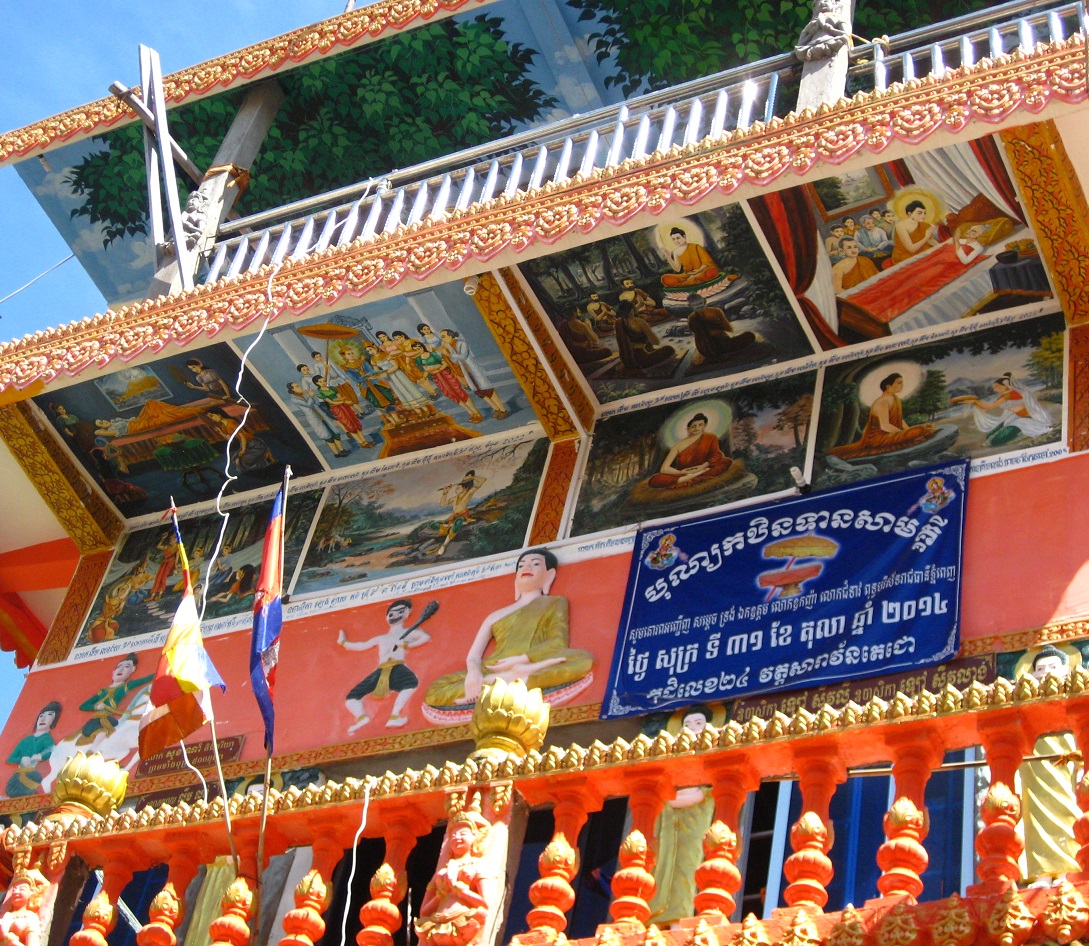 This was the first temple we visited, having wandered in here as we were passing by. It is a working temple: so much so that we weren’t sure whether we should even be inside the walls. The monks, nuns, and other inhabitants looked at us curiously, but they weren’t at all hostile, and one monk confirmed that we could go inside the main pagoda. It was a pretty space, though my favorite part was the monk sitting at a laptop to the left of the main altar/buddha statue. This temple is actually one of the oldest in Phnom Penh, and it had multiple memorial stupas (mausoleums), statues, and a building with many beautiful frescoes. The reviews of this place seem to focus on a big red tower inside the complex, though I’m not sure why – other than age and its red color.
This was the first temple we visited, having wandered in here as we were passing by. It is a working temple: so much so that we weren’t sure whether we should even be inside the walls. The monks, nuns, and other inhabitants looked at us curiously, but they weren’t at all hostile, and one monk confirmed that we could go inside the main pagoda. It was a pretty space, though my favorite part was the monk sitting at a laptop to the left of the main altar/buddha statue. This temple is actually one of the oldest in Phnom Penh, and it had multiple memorial stupas (mausoleums), statues, and a building with many beautiful frescoes. The reviews of this place seem to focus on a big red tower inside the complex, though I’m not sure why – other than age and its red color. - Wat (Temple) Lang Ka:
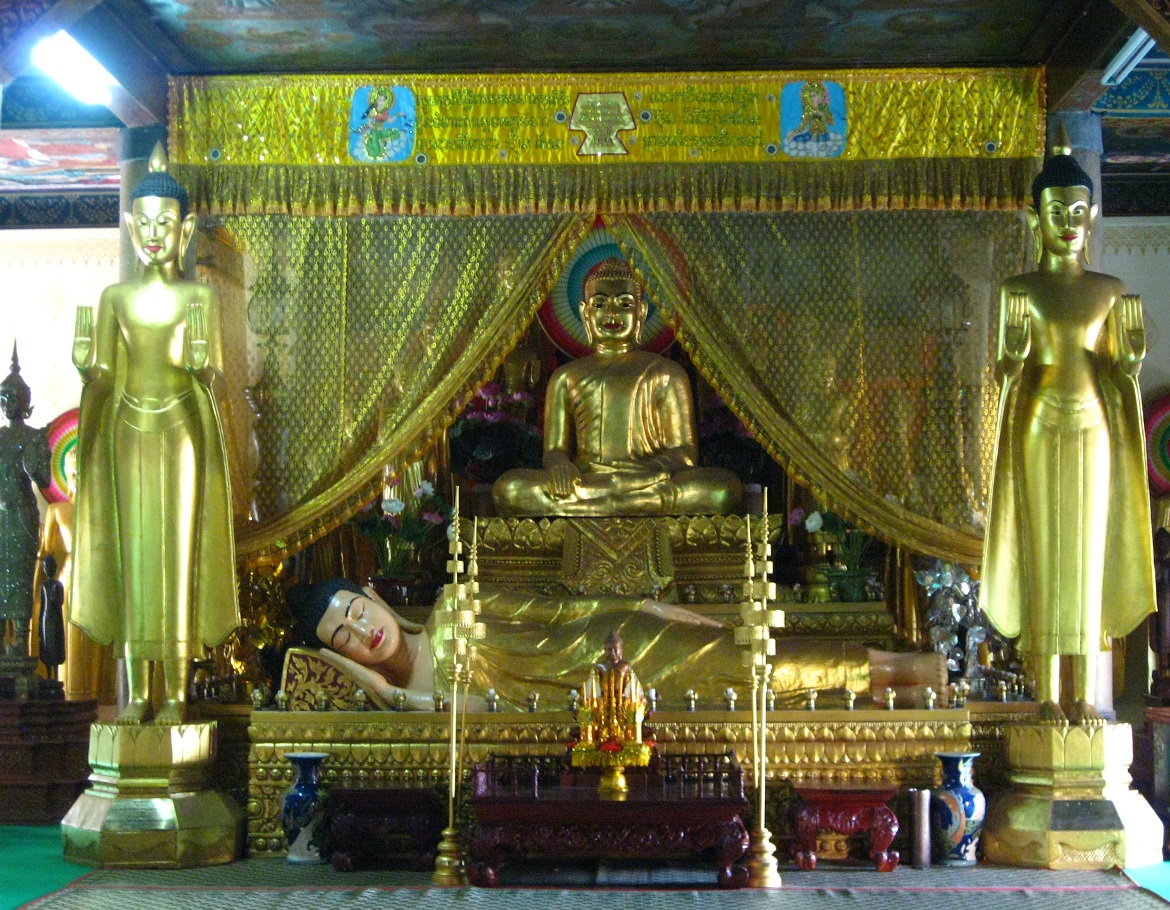 This temple is across the street from the Independence Monument – but was surprisingly free of tourists when we visited. Its differentiation is that it offers meditation sessions on many days of the week. We unfortunately didn’t get a chance to go to those, but the temple itself was nice. It was less busy than Sarawan, and the inside of the prayer area had a big buddah on its side, in gold.
This temple is across the street from the Independence Monument – but was surprisingly free of tourists when we visited. Its differentiation is that it offers meditation sessions on many days of the week. We unfortunately didn’t get a chance to go to those, but the temple itself was nice. It was less busy than Sarawan, and the inside of the prayer area had a big buddah on its side, in gold. - Unknown Wat #1: I can’t seem to find this one on a map or on any guide, and there was no name plate when we were there. However, this temple is notable for the little kids who were sitting in front of it (normal enough for a temple) holding a handgun (not normal). We booked it out of there.
- Unknown Wat (Temple) #2:
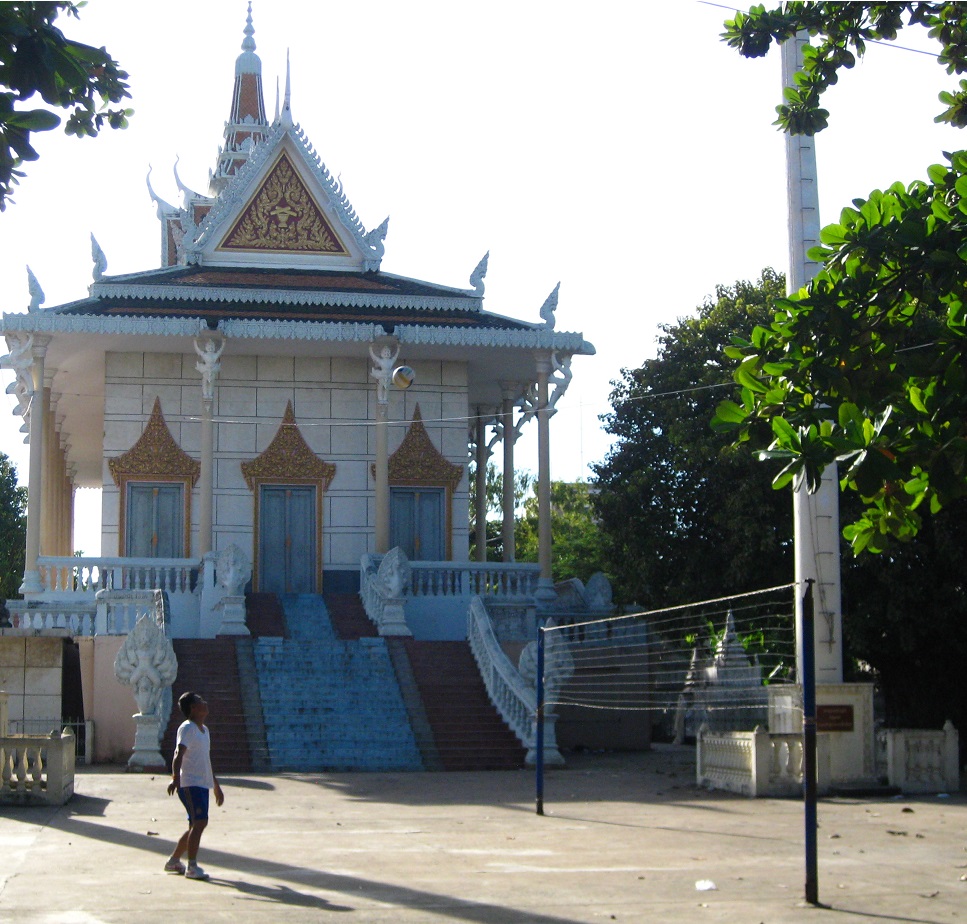 This temple was similarly un-labeled. We didn’t go inside the prayer area, because two men were playing volleyball in front of it! We did sit in the courtyard for a bit though, where we spotted several locals throwing and breaking CDs and computer drives. The amassing garbage was unfortunate, though the devaluation of this kind of technology – even in a relatively poor place – was interesting.
This temple was similarly un-labeled. We didn’t go inside the prayer area, because two men were playing volleyball in front of it! We did sit in the courtyard for a bit though, where we spotted several locals throwing and breaking CDs and computer drives. The amassing garbage was unfortunate, though the devaluation of this kind of technology – even in a relatively poor place – was interesting. - Royal Palace: This is on all of the must-do tourist lists, though they mostly mention the big pagoda inside, and that was not my favorite. The Royal Palace is what it sounds like: the traditional grounds of the Cambodian royal family. It includes a big Wat (temple), called the Silver Pagoda by foreigners – for its pure silver floor, or the Emerald Temple by locals – for its pure green jade buddha. Inside are many artifacts, including various figurines, gifts, etc. given to the king. Aside from this temple, there are also memorial stupas (mausoleums) for past kings – but only those liked by the populace! (Four out of seven, in case you’re curious.)
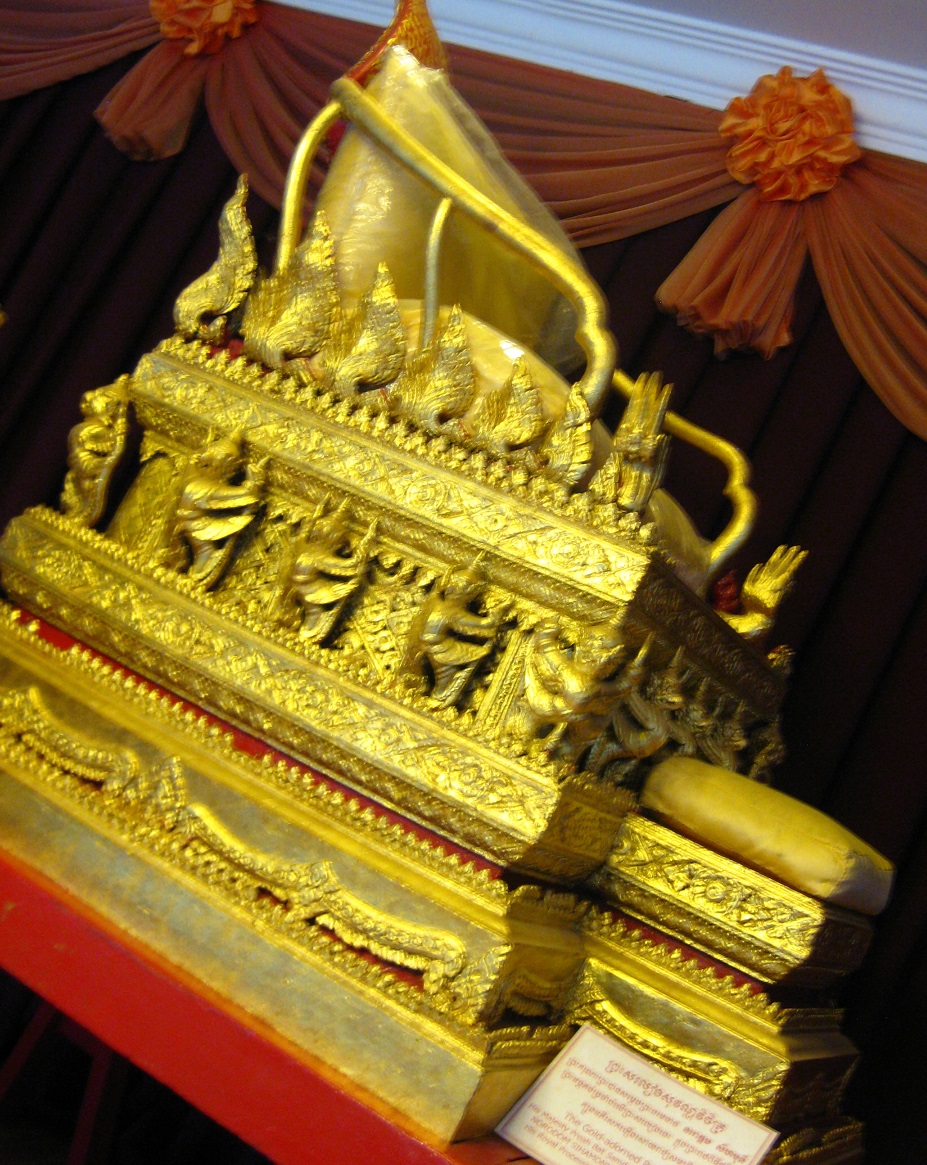 Other attractions include: a little koi pond, a model of Angkor Wat, several smaller pagodas, a bell tower, a statue of a man on a horse, many beautiful wall paintings, and a mini forest area on a hill. In addition to these parts of the grounds, there are the tourist-centric areas: a display on traditional Cambodian dress and housing, a display of sedan chairs in the former albino elephant stable, and a display of the king’s coronation regalia. The most fun part was the local, live music being played near the exit. The most shameful part was when the woman on our three-person tour straight out asked our local guide if the recently-crowned king was unmarried (a topic of grave concern, based on its frequency of mention) because ‘he preferred the company of other men.’ (Yes, this is an open topic in Seattle, where you’re from, but could be potentially insulting to a Cambodian, so perhaps something to research on Google, if you’re that curious.) The most interesting part was how many of the king’s ‘privileges’ (golden robes, crown and slippers, etc.) were only for his coronation. I wondered if this was to keep the king humble – a funny thought, given that it is a ceremonial position, not unlike the Queen of England. Though, they do plaster the king’s face on many more things around the country: a photo of the king, king father, and queen mother are even on display inside many restaurants in the countryside, far from the capital. The final point of interest is the grassy knoll in front of the Palace, facing the river: at night, it’s home to playing children and picnicking adults: fun to see!
Other attractions include: a little koi pond, a model of Angkor Wat, several smaller pagodas, a bell tower, a statue of a man on a horse, many beautiful wall paintings, and a mini forest area on a hill. In addition to these parts of the grounds, there are the tourist-centric areas: a display on traditional Cambodian dress and housing, a display of sedan chairs in the former albino elephant stable, and a display of the king’s coronation regalia. The most fun part was the local, live music being played near the exit. The most shameful part was when the woman on our three-person tour straight out asked our local guide if the recently-crowned king was unmarried (a topic of grave concern, based on its frequency of mention) because ‘he preferred the company of other men.’ (Yes, this is an open topic in Seattle, where you’re from, but could be potentially insulting to a Cambodian, so perhaps something to research on Google, if you’re that curious.) The most interesting part was how many of the king’s ‘privileges’ (golden robes, crown and slippers, etc.) were only for his coronation. I wondered if this was to keep the king humble – a funny thought, given that it is a ceremonial position, not unlike the Queen of England. Though, they do plaster the king’s face on many more things around the country: a photo of the king, king father, and queen mother are even on display inside many restaurants in the countryside, far from the capital. The final point of interest is the grassy knoll in front of the Palace, facing the river: at night, it’s home to playing children and picnicking adults: fun to see! - National Museum:
 I read that the museum was looted and its director killed by the Khmer Rouge. From that perspective, it’s amazing how much is inside here; however, even if you take it slow, it likely won’t take longer than an hour and a half. There was a small modern art section, with a few unique works. Also interesting was an entire exhibit about the return of native Cambodian art which had turned up at the NYC Sotheby’s for auction in the 90s; spoiler alert: it was returned to the local government. There were also loads of statues of the Hindu gods Vishnu, Shiva, and Brahma, some of them pre-Angkorian (read: older than Angkor Wat, the site so famous that it’s on the Cambodian flag). A warning: there are older ladies inside the museum who try to give you flowers to put in front of these statues, in return for money. They don’t appear to be affiliated with the museum, they are quite persistent, and they re-use the flowers for the next ‘guest.’ Donate if you like; just be aware that the funds go to the ladies themselves. The center of the museum is a big courtyard, which makes for a popular photo opp and a relaxing break from the heat. The exterior of the building is also pretty. Overall, somewhat overpriced by local standards, but I didn’t mind supporting the visual arts this way.
I read that the museum was looted and its director killed by the Khmer Rouge. From that perspective, it’s amazing how much is inside here; however, even if you take it slow, it likely won’t take longer than an hour and a half. There was a small modern art section, with a few unique works. Also interesting was an entire exhibit about the return of native Cambodian art which had turned up at the NYC Sotheby’s for auction in the 90s; spoiler alert: it was returned to the local government. There were also loads of statues of the Hindu gods Vishnu, Shiva, and Brahma, some of them pre-Angkorian (read: older than Angkor Wat, the site so famous that it’s on the Cambodian flag). A warning: there are older ladies inside the museum who try to give you flowers to put in front of these statues, in return for money. They don’t appear to be affiliated with the museum, they are quite persistent, and they re-use the flowers for the next ‘guest.’ Donate if you like; just be aware that the funds go to the ladies themselves. The center of the museum is a big courtyard, which makes for a popular photo opp and a relaxing break from the heat. The exterior of the building is also pretty. Overall, somewhat overpriced by local standards, but I didn’t mind supporting the visual arts this way. - Apsara Dancing: On the grounds of the National Museum is an outdoor amphitheatre where the Cambodian Living Arts group performs shows, every day except Sunday. We attended their original show, which included eight different local dances. Even beyond the really inspiring history of this group, their performances were quite polished and – more importantly, fun! I would highly recommend this. Just bring some bug spray, or borrow the bottle they have at the cash register. (If you buy your tickets by 4 pm the day of the performance, you get $1 off, though it seems silly to quibble over such an amount, which is nothing to most of us, but quite a bit to them.)
- Sisowath Quay: This is the riverfront, starting at the Royal Palace and going north. Though there are plenty of Western chains – from DQ to Pizza Hut, many of the locals spend time here. At night, couples sit on the cement wall along the river, and kids run around. During the day, some people pay or exercise on the public equipment on the northern part of the riverfront. It’s a busy area that makes for fun people-watching.
- The Killing Fields (Choeung Ek):
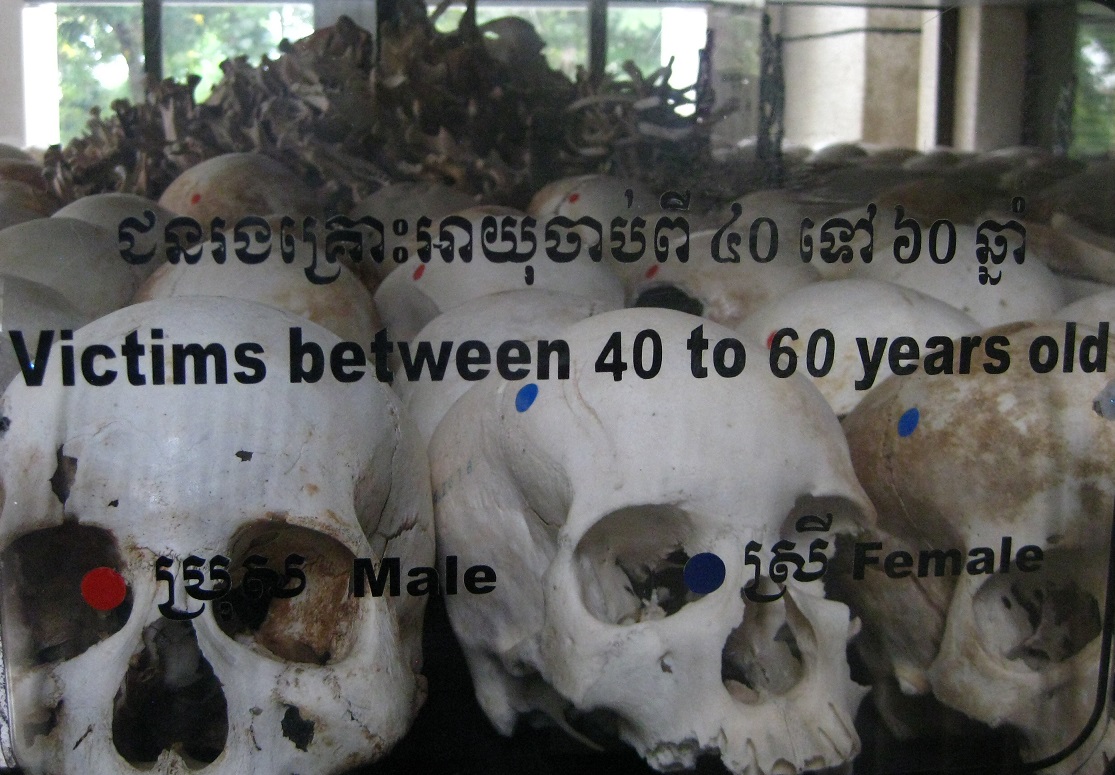 This is best described as Cambodia’s version of an extermination camp (a la the Holocaust). It was run by the Khmer Rouge in the early 1970s (yes, thirty years after the discovery of Hitler’s death camps). Their goal was to create a fully agrarian communist society, so they decided to ‘dispose’ of anyone who posed a threat to this model: anyone educated, anyone who knew another language, anyone suspected of resisting the regime (including forced evacuation of all cities) – all the way down to anyone who wore glasses. Because they obviously got them to read, and none of that would be necessary in a society of farmers! Of course, the people effecting this ‘commoner’ revolution were an oligarchy of foreign-educated, multilingual teachers! This particular field was long ago a very small Chinese cemetery, but he Khmer Rouge turned it into a giant mass grave. [Warning: Stop reading now if you are prone to nightmares.] They would ship people here who had ‘confessed’ under torture at the Tuol Sleng Prison and take them out one by one, still blindfolded and bound, and kill them by slitting their throats or hitting them with rods, machetes, or whatever they had handy. They played communist propaganda songs to cover up the screams. They killed entire families, so there would be no one to take revenge?
This is best described as Cambodia’s version of an extermination camp (a la the Holocaust). It was run by the Khmer Rouge in the early 1970s (yes, thirty years after the discovery of Hitler’s death camps). Their goal was to create a fully agrarian communist society, so they decided to ‘dispose’ of anyone who posed a threat to this model: anyone educated, anyone who knew another language, anyone suspected of resisting the regime (including forced evacuation of all cities) – all the way down to anyone who wore glasses. Because they obviously got them to read, and none of that would be necessary in a society of farmers! Of course, the people effecting this ‘commoner’ revolution were an oligarchy of foreign-educated, multilingual teachers! This particular field was long ago a very small Chinese cemetery, but he Khmer Rouge turned it into a giant mass grave. [Warning: Stop reading now if you are prone to nightmares.] They would ship people here who had ‘confessed’ under torture at the Tuol Sleng Prison and take them out one by one, still blindfolded and bound, and kill them by slitting their throats or hitting them with rods, machetes, or whatever they had handy. They played communist propaganda songs to cover up the screams. They killed entire families, so there would be no one to take revenge? 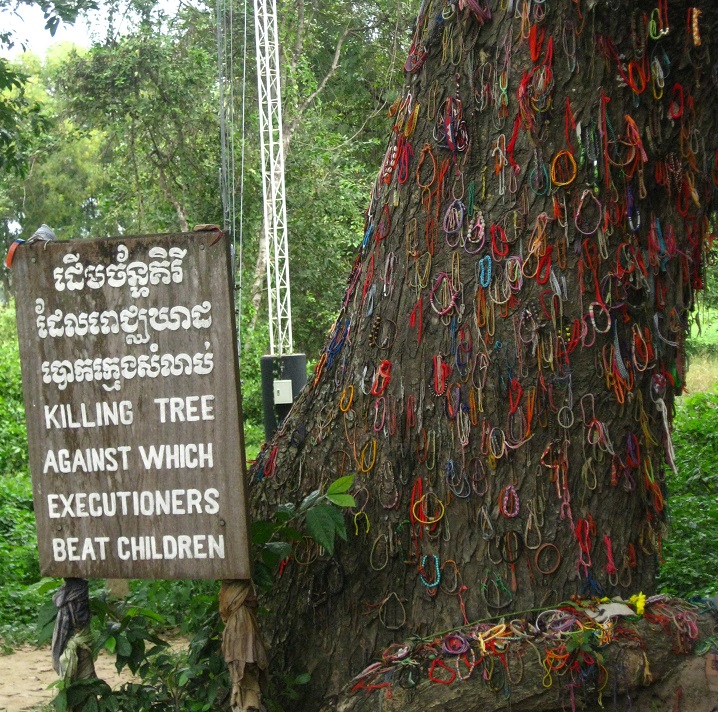 But they killed the babies in front of their mothers, by swinging them into a tree and bashing their brains out. There is a self-guided audio tour on-site that details all this, along with survivors’ and even guards’ stories. As you walk through the space, you’ll see the clothing and bones of the crucified victims coming up from the mass graves, as the ground shifts from rain, etc. In the middle of the field is a giant memorial stupa (mausoleum), which showcases the skulls of some of the more than nine thousand people killed here. (Some claim that this is disrespectful of Buddhist practice, which is to cremate bodies. However, I heard a teenager in the countryside describe how he had doubted the Khmer Rouge stories until he saw the bodies, the proof, so I think I understand why they keep it as is.) Overall, a very moving site and worth seeing; at a minimum, to pay your respects to the millions who died during the Khmer Rouge’s reign, many of them anonymous and ignored by the international community, who helped create the conditions that made it possible.
But they killed the babies in front of their mothers, by swinging them into a tree and bashing their brains out. There is a self-guided audio tour on-site that details all this, along with survivors’ and even guards’ stories. As you walk through the space, you’ll see the clothing and bones of the crucified victims coming up from the mass graves, as the ground shifts from rain, etc. In the middle of the field is a giant memorial stupa (mausoleum), which showcases the skulls of some of the more than nine thousand people killed here. (Some claim that this is disrespectful of Buddhist practice, which is to cremate bodies. However, I heard a teenager in the countryside describe how he had doubted the Khmer Rouge stories until he saw the bodies, the proof, so I think I understand why they keep it as is.) Overall, a very moving site and worth seeing; at a minimum, to pay your respects to the millions who died during the Khmer Rouge’s reign, many of them anonymous and ignored by the international community, who helped create the conditions that made it possible.
What We Skipped:
- Tuol Sleng Genocide Museum: We had read and heard about this former Khmer Rouge prison at the Killing Fields and were quite saddened already, so we opted out of coming here.
- Wat (Temple) Ounalom: This temple seemed a bit more touristy, and we had already visited four, so we passed.
- Wat (Temple) Phnom: Ditto the above.



We have a dear friend who escaped the Khmer Rouge on a tiny boat with her family. Her story is astonishing in every sense of the word.
Pingback: What We Saw in Kep - Novelty Buffs
Pingback: Moments in a Cambodian Village - Novelty Buffs
Pingback: Most Memorable Moments in Cambodia - Novelty Buffs